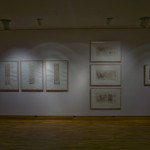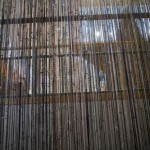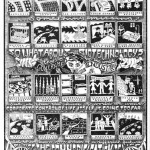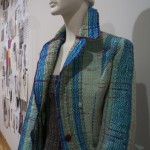Green Horizons
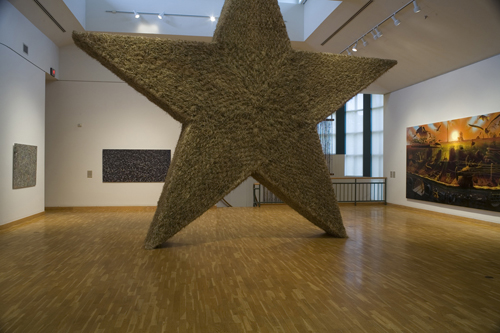 June 9 – December 9
June 9 – December 9
This ambitious interdisciplinary, off the grid project will enspire artistic, environmental, economic, and social conversations surrounding an urgent 21st century topic: “What is green and is sustainable?” Changing with every visit to the Museum or one of its site specific works, Green Horizons is an organic exhibition and educational outreach program designed to examine the politics and nature of greeness and sustainability.
This exhibition brings together internationally renowned artists Agnes Denes, Chris Jordan, David Maisel, Beth O’Halloran, Alexis Rockman, Anne-Katrin Spiess, Virginia Valdes and Maine artists Karen Adrienne, Mark Silber, Michael Shaughnessey, and the Beehive Collective. It also includes new work by artists in collaboration with Bates faculty, staff, students and community organizations: Christina Bechstein with David Scobey of the Harward Center for Community Scholarship; Seitu Kenneth Jones and Bruce Barnes with English professor Kimberly N. Ruffin; Julie Patton with environmental studies professor and eco-poet Jonathan Skinner; PearsonWidrig DanceTheater and composer Robert Een with Bates Dance Festival Director Laura Faure; dance professor Carol Dilley and music professor William Matthews. Museum L/A, Stanton Bird Club, and Kristen Walter ’00 of Lots to Garden are also involved in these projects, breaking the mold and paradigm of traditionally conceived museum exhibitions.
The cornerstone of Green Horizons is Alexis Rockman’s Manifest Destiny, (commissioned by the Brooklyn Museum of Art) which depicts the artist’s apocalyptic vision of global warming’s impact. This painting provides a grand landscape, in the manner of the Hudson River Valley School, of Manhattan in the year 5000 after three millennia of global warming. Its presence invites the discussion of complex issues, including community, prophecy, humankind’s often unintentional impact on local and global ecosystems, and how we react to those impacts. The exhibition will embrace these issues as its main themes through which other artworks will explore the politics, nature, and spirit of greenness and sustainability.
Perhaps nowhere in the United States is the environment more central to a region’s way of life than it is here in Maine. Maine plays a unique role in the densely populated Northeast region of the country, and environmental issues are of particular importance. Maine has nine million acres of unorganized territories, and more than 85 percent of the state is forested. Maine features mountainous terrain, one of the longest coastlines in the continental United States, and an abundance of lakes. As part of the larger community of Maine, Bates has a commitment to sound environmental practices as well. For years, the College has been cited for its successful recycling program. Bates is the largest purchaser of green power both within the New England Small College Athletic Conference and among all small, private liberal arts colleges in the EPA’s Green Power Partnership, a voluntary program helping to increase the use of green power. The College’s Program in Environmental Studies is one of the oldest and largest in the region. It stands as a model that has successfully integrated the many disciplines that define study of the environment and is equally strong in science, public policy, and the arts.
The Bates College Museum of Art is a laboratory for the visual arts, providing an environment for broad audiences to explore and discover synergies created by visual art in the context of the liberal arts. The Museum embodies the new academic museum for the 21st century by working collaboratively with artists, students, faculty, and other museums to create exhibitions that offer new scholarly explorations and educational programming linked closely to local communities. Through original exhibitions, programming, and a growing collection the museum is committed to expanding art history and identifying specific artists and artistic trends that address local and global issues in context. Today Bates joins other academic museums by challenging a museum environment increasingly dominated by commercialism. Unlike traditional academic museums that became insular by looking to the past for answers about the past, the Bates College Museum of Art celebrates the past, assesses the present, and moves toward the future. It is a laboratory for creative thought, a site of synergy where artists, curators, scholars, students, and visitors engage art together.
In support of the evolving mission and its challenge to traditional museum methodology, Bates received a generous gift: a “synergy” fund dedicated to the development of education with focus on the synchronistic parallels in time and space across the subject matter of the liberal arts. This Synergy Fund supports efforts to look critically at the organization, exhibitions and how curators undertake and communicate that process. While the museum does this on a modest scale with each exhibition, the Fund now allows the museum to mount Synergy Exhibitions: ambitious projects that have strong links across the curriculum to the research, teaching, and learning of the College. The project is also generously supported by Lee Smith, Jane and Alan Lehman, LEF Foundation and additional funding from the Maine Arts Commission, Margaret E. Burnham Charitable Trust, and Charles W. Radcliffe ’50.
Green Horizons Catalog
Adobe Acrobat Reader is needed to view this document
- Senior Thesis Exhibition 2007

